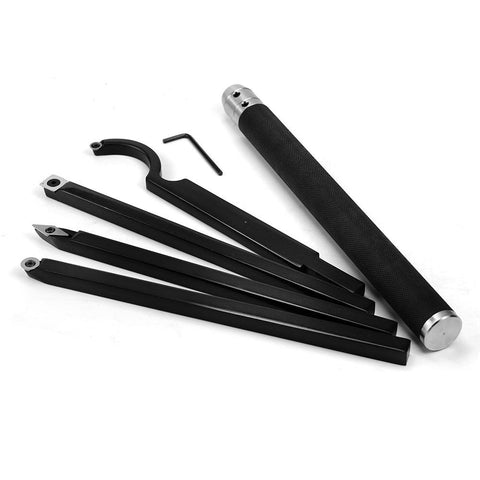In the world of woodturning, achieving precision and stability is crucial, and one of the key components that ensures these qualities is the woodturning lathe faceplate. The faceplate, though often overlooked in the spotlight of the lathe itself or the tools used to shape the wood, plays an indispensable role in safely and securely holding the workpiece while it is being turned. This unassuming accessory is the linchpin that allows woodturners to craft everything from intricate bowls and vases to massive wooden sculptures with precision and ease.
A lathe faceplate is a flat, circular metal disc that attaches to the spindle of a woodturning lathe. It features a set of screw holes around the perimeter where the workpiece can be securely fastened using wood screws or threaded inserts. The faceplate is often used for turning larger pieces of wood or those with irregular shapes that cannot be easily mounted with a traditional chuck. The faceplate's ability to support heavy or uneven materials makes it an essential tool for turning a variety of wood projects, particularly those that require more robust mounting than what can be achieved with a simple tailstock or small chuck.
One of the primary reasons woodturners rely on faceplates is their versatility in mounting large or oddly shaped pieces. When working with a heavy chunk of wood, a faceplate provides the necessary stability to keep the workpiece in place while the lathe spins it at high speeds. Without the proper support, the wood could wobble or even fly off the lathe, posing a danger to the woodworker. By using a faceplate, the turner can confidently cut, shape, and refine the wood without worrying about the piece shifting or coming loose. This feature is particularly beneficial when working with large bowls, table legs, or other substantial projects that demand both precision and strength.
The versatility of the faceplate also extends to its compatibility with various woodturning projects. While many lathes come with a chuck to hold smaller, more symmetrical pieces, the faceplate can handle the demands of larger or less symmetrical workpieces, making it an invaluable tool for turning objects like deep bowls, platters, or even sculptures. Additionally, it allows woodturners to create projects that require working from both ends of the piece. For example, when turning a large bowl, a turner might use a faceplate to mount the blank, turn the exterior, then reverse the piece and remount it on the same faceplate to finish the interior.
The design of a lathe faceplate is crucial for ensuring that the workpiece remains securely attached to the lathe while the cutting tools are applied. Typically, faceplates have a central mounting hole designed to fit the spindle of the lathe. The faceplate itself is often made of steel or cast iron, materials known for their durability and strength. The surface of the faceplate is flat and smooth, providing an even contact point for the workpiece. To ensure a tight grip, the faceplate is equipped with holes along the edges where screws or nails can be driven into the wood to hold it firmly in place. Some advanced models feature threaded inserts that allow for easier attachment and removal, further improving the speed and efficiency of the turning process.
Despite the benefits, working with a faceplate does require some skill and caution. The screws used to secure the workpiece need to be placed with care to avoid damaging the wood. Uneven pressure or poorly placed screws can lead to cracks, splits, or a warped shape, which could ruin the entire piece. Additionally, because the faceplate is attached to the lathe's spindle, it's important to ensure that it is securely fastened to prevent any wobbling or shifting during operation. When set up correctly, however, the faceplate ensures a smooth turning experience with minimal risk of damage.
Another consideration when using a faceplate is the potential for marks or blemishes left on the workpiece. The screws that attach the workpiece to the faceplate can sometimes leave indentations or holes in the wood, particularly if the piece is soft or delicate. To mitigate this, woodturners often use blocks or shims placed between the faceplate and the workpiece to distribute the pressure more evenly. This not only helps protect the wood but also provides a more secure fit. Some turners opt for specially designed faceplates that feature a ring of rubber or plastic inserts to reduce the chance of damaging the wood.
In terms of maintenance, lathe faceplates are generally durable and require minimal upkeep. However, regular checks for wear and tear are essential to ensure they remain in good working condition. Over time, faceplates may accumulate sawdust or resin, so cleaning them regularly is important to prevent any buildup that could affect performance. Additionally, ensuring that the threaded holes for attachment remain in good condition is crucial for keeping a secure connection between the faceplate and the lathe.
In essence, the woodturning lathe faceplate is an indispensable tool that enhances the woodturning process by offering both security and versatility. Whether you are turning a large bowl, a sculptural piece, or a functional object like a platter or table leg, the faceplate provides the necessary support and stability to make the project safe and successful. Its design allows woodturners to confidently tackle larger, more complex projects, making it a must-have accessory in any woodturning workshop. With proper care and use, a lathe faceplate ensures that every project is turned with precision, allowing artisans to bring their creative visions to life with skill and safety.


